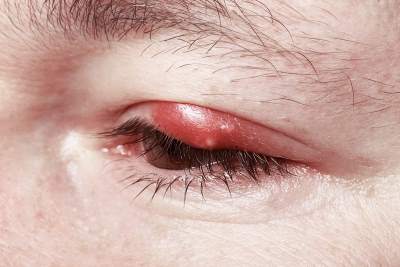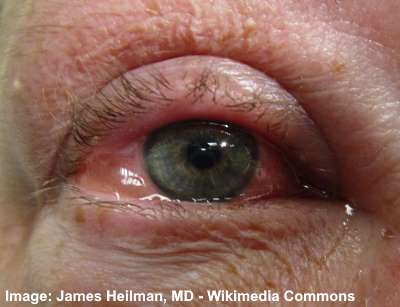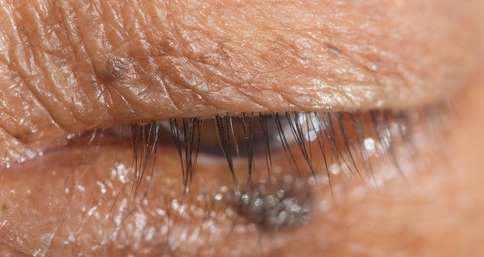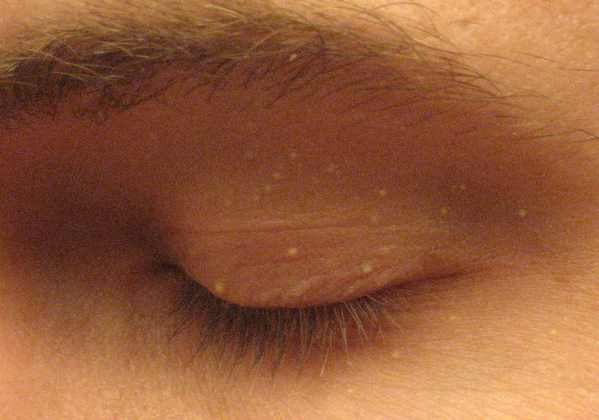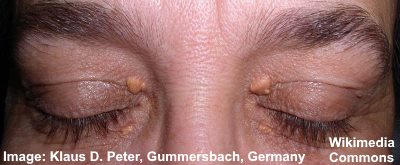Pimples or Bumps on Eyelids: Causes and Treatments
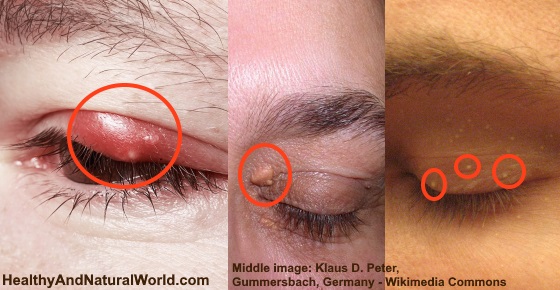
The area around the eye is a very sensitive and having a bump or pimple on your eyelid can be very painful. Because the eyelid bump can become red and swollen, it can also cause a person distress and to feel self-conscious.
The most common kind of bumps or pimples on eyelids are styes, chalazia, milia spots, and papillomas and they can appear on the eyelid or along the edge of the eyelid. Most bumps that appear on the skin that protects your eyes are harmless and they should go away on their own. Sometimes, infections can cause redness, swelling and itching on your eyelid or eyelid rim. This may result in having watery eyes and possibly some discharge from your eye. Other times, the lumps resemble small white pimples on the eyelid and can usually be left alone.
There are many simple home remedies that can help to cure infected eyelid bumps and help to reduce swelling and redness. They can provide welcome relief if the eyelid bump causes a gritty or itchy sensation in your eye.
On rare occasions, a bump or a pimple on your eyelid may not go away or may interfere with your vision, and in those circumstances, it is best to visit your doctor or ophthalmologist.
Bumps or Pimples on Eyelids – Causes and Treatments
Let’s look at the various reasons why you might have a bump or a pimple on your eyelid. You will also find helpful home remedies that quickly help to treat infected red lumps on your eyelid.
Styes (Sties)
A stye (the medical term is hordeolum) starts out as a small red pimple-like bump on or near the rim of your eye and becomes increasingly painful. It may become itchy and tender to touch and will probably start to cause discomfort as the infection develops. If the eyelid infection becomes worse, the stye may resemble a boil or cyst on your eyelid. Sometimes styes can form a small painful bump on the inside of your eyelid, called an internal hordeolum.
According to ophthalmologist Dr. Franklin W. Lusby from the Lusby Vision Institute, styes occur when one of the oil glands on the eyelid becomes blocked. When this happens, bacteria can cause a staphylococcal infection which causes the skin around the blocked gland to become red and swollen.1 They will usually become filled with pus. In fact, a stye is similar to pimples that occur when hair follicles get blocked.
The stye on your eyelid may also become itchy, causing a sensation that you need to scratch your eye or remove a foreign body from your eye. In some cases, your eye may become more sensitive to light.
One of the best home remedies to get rid of a stye is to apply a warm compress to the infected eyelid lump. Dr. Kathleen Romito on WebMD recommends applying a warm damp compress for 5 to 10 minutes, up to 6 times a day to help the stye heal quicker.2
To use a warm compress to get rid of a stye and speed up the healing process, this is what you should do:
- Soak a clean washcloth in warm water and squeeze out excess water.
- Gently place the warm compress to the stye and hold it there for 5-10 minutes to increase blood circulation to the infected area and help the pus to drain.
- Repeat the process 3-6 times a day until the stye goes away or some pus comes out.
Alternatively, you can also use a warm tea bag to help cure a stye naturally and soothe irritated eyes. Tea contains natural astringent properties that can help to reduce swelling and puffiness. A study also showed that tea is rich in antioxidants and green tea even has antibiotic properties which can help to reduce the bacteria that cause infections.
So, instead of the warm washcloth, dip a black or green tea bag in hot water for a few minutes. Squeeze out the excess water and make sure the tea bag is not hot. Gently hold the tea bag to the red lump on your eyelid for 5 minutes to help get rid of the stye quicker. Repeat up to 6 times a day until the inflammation around your eye has gone away and the discharge has stopped.
Aloe vera is another natural remedy for styes because of its soothing effect and anti-inflammatory properties. One study published in the journal Skin Pharmacology and Physiology showed that aloe vera is an excellent natural remedy to help reduce redness and swelling on many skin conditions.3
Use pure aloe vera gel to heal a stye faster by applying some gel to the affected area and leave it on for around 20 minutes. Rinse off with warm water. Repeat 3 times a day to help reduce itchiness and redness of the infected eyelid.
You should always avoid trying to burst, pop, or squeeze the pus from the stye. Doing so could force the infection deeper into your eyelid causing complications and make it more difficult to treat.
For more home remedies to treat styes quickly, please read my article about the best natural remedies for eye stye.
Chalazion
If the inflamed oil gland becomes totally blocked, the stye may turn into a chalazion (the plural of a chalazion is chalazia). According to Dr. Andrew A. Dahl on eMedicineHealth, the eyelid lump forms when the oil builds up in a blocked gland forming a lump or eyelid cyst. He says that the lump is usually painless, but the area around the chalazion may be tender to touch.4
If the lump on the eyelid becomes very large, it could interfere with your vision and you should see a doctor to get the lump treated. According to the National Health Service in the United Kingdom, most chalazia can be treated at home by using a warm compress in a similar way to how you would get rid of a stye. If the cyst on your eyelid doesn’t go away by using natural remedies, you should visit your doctor.5
Stye vs Chalazion
Both styes and chalazia cause lumps on the eyelids and both are caused by an oil gland being blocked.
According to the American Academy of Ophthalmology, styes are caused by an infected eyelash follicle whereas a chalazion forms when an oil-producing gland in the eyelid (called the meibomian gland) becomes enlarged and clogged with oil. Chalazia tend to develop farther from the edge of the eyelid than styes and are often larger than stye.9 Styes are usually always red and painful, whereas chalazia usually only become painful if an infection develops in the swollen eyelid bump. A chalazion can form into a large lump on your eyelid that can affect your vision.
Conjunctivitis (Pink Eye)
A viral infection of the eye or an allergic reaction can cause conjunctivitis which can result in the eyelids becoming swollen, red, and produce discharge.
Dr. Jay Robert Woody on MedicineNet says that allergic conjunctivitis occurs when allergens like dust mites, pet dander, and pollens affect the eyes. This can cause redness, itching, a burning sensation, and eyelid swelling.6 The same symptoms can occur if a virus has caused an infection in your eye, sometimes referred to as pink eye conjunctivitis.
Very often you can help relieve the symptoms of conjunctivitis and reduce the swelling of your eyelids by placing a warm tea bag on your affected eye. For this, it is better to use cooled tea bags to help reduce the swelling in your eyelid.
Apply the cool tea bags to your eye for 10 minutes and up to 4 times a day until the swelling and redness disappear.
You can find more information on how to use aloe vera, turmeric, and calendula tea to treat the symptoms of conjunctivitis in my article about the best home remedies for pink eye.
Papillomas / Skin Tags
The appearance of small lumps on your eyelid could be eyelid papillomas caused by the papilloma virus. These small harmless skin tags can form on your eyelid or close to your eyelid rim. Usually, the only reason to get rid of papillomas is for cosmetic reasons or if they start to interfere with your vision.
Various websites recommend apple cider vinegar to remove papillomas as well as other skin tags. However, apple cider vinegar can cause great irritation to your eye and should not be used to remove eyelid papillomas.
So, if the skin tags on your eyelid are bothering you, it is best to visit your doctor who can recommend the best way to have them removed.
Milia Spots
If you notice small pearly-white pimples on your eyelid or around your eye area, you could have milia spots. These small harmless lumps on the eyelid are actually tiny cysts containing keratin (a protein that forms in the skin). According to dermatologist Dr. Monisha Gupta, milia mostly occur around the eyelids and cheeks but can show up anywhere on the body.7
A similar condition called keratosis pilaris can affect larger areas of the body and give the appearance of bumpy skin.
Dermatologists say that milia spots don’t need to be treated unless they are causing distress for the patient. Usually, doctors will remove the lump by using a sterile needle to prick out the excess keratin. However, you should never try to remove milia spots from around the eye area yourself as you could cause the eyelid to become infected or severely damage your eye.
Xanthelasma
Yellowish or skin-colored painless bumps on your eyelid could be a buildup of cholesterol under the skin called xanthelasma. These lumps are more commonly found on the upper eyelid, but can also affect the lower eyelids. It’s important not to ignore these types of bumps around your eyelids because they could be a sign of more serious underlying health problems.
Dr. Debra Jaliman on WebMD says that people with high cholesterol tend to develop these raised patches of skin on the eyelids. Therefore, xanthelasma could be a sign that you are at risk of heart disease.8
A study published in the British Medical Journal in 2011, suggested that there is a link between heart disease and the yellow markings medically known as xanthelasmata or xanthelasma palpebrarum.9
Xanthelasma occurs in both men and women and is more common after the age of 40. Research has established that these yellow plaques are deposits of cholesterol and are linked to higher than average cholesterol levels in about half of the cases. They don’t interfere with the vision, they are soft and painless, and are not dangerous in themselves, so many people ignore them. Some choose to remove them for aesthetic purposes and don’t give it much thought, potentially missing an important warning sign. When removed, they often reoccur.
A Danish based study (the Copenhagen City Heart Study) looked at the correlation between xanthelasmata and heart disease in the general population. The research team reached some conclusions that will change the way many people and clinicians view these seemingly harmless spots.9
A large prospective study included 12,745 people aged 20 to 93 years, who were free of ischemic heart disease at the beginning of the study. The participants were followed from 1976-8 until 2009.
In all age groups, the risk of heart attack, heart disease and death increased significantly in the presence of xanthelasma. Both men and women with the yellow eye lid marks were more likely to suffer a heart attack or die within a 10-year period.
Generally speaking, men are inherently more prone to develop heart disease.
- The study found that men aged 70 to 79 years were at the highest risk, and the risk was further increased by 12% in the presence of xanthelasma.
- Women with xanthelasmata were 8% more likely to develop a heart attack compared to their counterparts without the yellow patches.
Since women have a smaller inherent risk of developing heart disease, xanthelasmata have a larger prediction value in this group, as explained by the authors of the study.
The study concluded that xanthelasmata predict risk of heart attack, ischemic heart disease, severe atherosclerosis and death, independently of other risk factors, such as smoking, high blood pressure, cholesterol levels and obesity.
The findings are believed to assist with the diagnosing of heart conditions, and could be particularly valuable in places where access to laboratory facilities is scarce.
If you notice yellowish marks on your upper or lower eyelids, it would be recommended to have your plasma lipid (fat) levels checked. As the plaques can be an indicator of high cholesterol, consider lifestyle and diet changes to support your heart and overall health.
The best way to prevent these lumps from developing on your eyelids is to keep your cholesterol at a healthy level. You can find some helpful advice in my article on how to lower your cholesterol in 10 easy steps.
Read these related articles:
- The Best Natural Remedies for Eye Stye (Sty)
- The Best Home Remedies for Pink Eye (Conjunctivitis)
- 10 Reasons to Use Cucumbers on Your Eyes
- 10 Health Warnings Your Eyes May Be Sending
Article Sources

